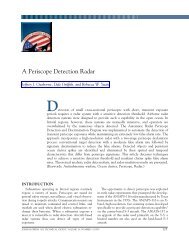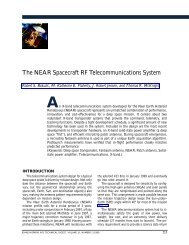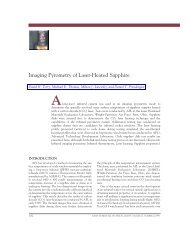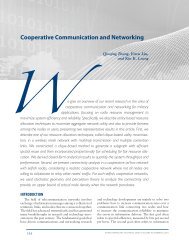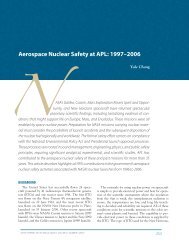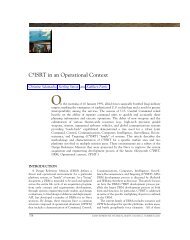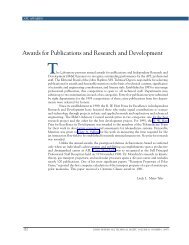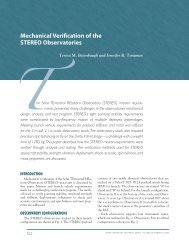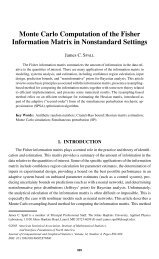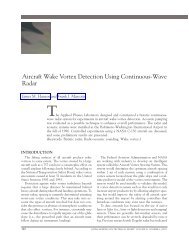Tomahawk Deconfliction - The Johns Hopkins University Applied ...
Tomahawk Deconfliction - The Johns Hopkins University Applied ...
Tomahawk Deconfliction - The Johns Hopkins University Applied ...
Create successful ePaper yourself
Turn your PDF publications into a flip-book with our unique Google optimized e-Paper software.
A. F. POLLACK, R. C. FERGUSON, AND A. K. CHRYSOSTOMOU<br />
[1 p()], if missiles 2 and 3 do not collide [1 p()],<br />
and if missiles 1 and 3 do not collide [1 p(2)]. This<br />
produces the following three-missile probability of at<br />
least one collision:<br />
1 {[1 p()][1 p()][1 p(2)]} , (1)<br />
or, using the mathematical approximation for small p,<br />
1 p e p , the 3-missile probability of at least one<br />
collision can be expressed as<br />
1 e [2p() +p(2)] . (2)<br />
Adding a fourth missile adds three new pairs of missiles<br />
(one pair seconds apart, one pair 2 seconds apart, and<br />
one pair 3 seconds apart) for a probability of at least<br />
one collision of<br />
1 e [3p() +2p(2)+ p(3)] . (3)<br />
Generalizing this to an N-missile equation for the<br />
probability of at least one collision among N missiles<br />
without TOT control yields<br />
−∑<br />
P( N)<br />
= 1−e<br />
i=<br />
1<br />
c<br />
N−1<br />
( N−i) p( i)<br />
.<br />
(4)<br />
Once the analytical methodology was in place, we<br />
determined the appropriate fixed-input parameters for<br />
the <strong>Tomahawk</strong> missile system. <strong>The</strong>se included navigational<br />
accuracy, which is based on relative GPS performance<br />
and altimeter specifications, and the speed fluctuations<br />
that result from air data system variations.<br />
Other parameters, such as length of mission, number of<br />
missiles, and initial missile separation, were allowed to<br />
vary so we could investigate different scenarios. Figure<br />
4 shows, for a 600-nmi common route and initial<br />
missile separations of 10, 30, and 60 s, curves of the<br />
probability of collision versus the number of Block III<br />
missiles without TOT control. <strong>The</strong> probability of collision<br />
values are omitted due to classification; however,<br />
the values are exponential in the number of missiles,<br />
and probabilities reached into the double digits. For<br />
missiles on common routes flying without TOT control,<br />
deconfliction is clearly required.<br />
To examine the deconfliction requirements for missiles<br />
using TOT control, we used the same basic equations.<br />
<strong>The</strong> input parameter that changes is the probability<br />
of passing, which depends upon the assigned TOT<br />
of the missiles. Missiles with very closely spaced TOT<br />
assignments could pass each other multiple times en<br />
route to the target. As the difference in assigned TOT<br />
approaches zero, the probability of collision approaches<br />
Probability of collision<br />
0<br />
600-nmi common route<br />
5<br />
10<br />
Number of missiles<br />
15<br />
10 s<br />
30 s<br />
60 s<br />
Figure 4. <strong>The</strong> N-missile probability of at least one collision.<br />
(<strong>Tomahawk</strong> Block III without time-on-target control). Curves show<br />
the probability of at least one collision en route to the target with<br />
initial missile separations of 10, 30, and 60 s.<br />
1 for missiles with identical assigned TOT as the length<br />
of the common route increases. As the TOT separation<br />
increases, the probability of collision rapidly decreases<br />
because of TOT speed calibration. An additional twist<br />
occurs if missiles with unique TOT assignments arrive<br />
on a common route out of sequence (that is, the missile<br />
with the later TOT arrives on the common route first).<br />
In this case, the probability of passing is 1, since the<br />
missile software essentially forces a pass to achieve the<br />
assigned TOT. Thus, TOT control presents a more<br />
complex probability of collision picture, but the need<br />
for deconfliction measures remains clear.<br />
<strong>Deconfliction</strong> Solution and Implementation<br />
Our analysis of the probability of collision was initiated<br />
shortly before the Block III missile was scheduled<br />
to arrive in the Fleet. Terminal fratricide had originally<br />
been considered the most likely area of interference;<br />
the relatively high probabilities of collision shown by<br />
the en route analysis had not been anticipated. After<br />
briefing the <strong>Tomahawk</strong> community on the analysis and<br />
achieving a consensus that the potential for en route<br />
interference was indeed high, we set out to define a<br />
solution that could be provided to the Fleet in time for<br />
the arrival of the <strong>Tomahawk</strong> Block III missiles. Because<br />
time was short, we took a two-phase approach, limiting<br />
the initial phase to a procedural solution. In the second<br />
phase, a wider range of options was considered.<br />
Whenever multiple missiles are trying to be in the<br />
same place at the same time, there is a potential<br />
for interference. Any deconfliction solution must remove<br />
one or more of these elements. How can this<br />
be achieved procedurally? <strong>The</strong> number of missiles in a<br />
given strike is driven by tactical considerations—what<br />
the required damage to the target area is and how many<br />
missiles are necessary to achieve that level of damage.<br />
Changing the number of missiles would interfere<br />
with achieving the strike objectives. <strong>The</strong> remaining<br />
20<br />
84 JOHNS HOPKINS APL TECHNICAL DIGEST, VOLUME 18, NUMBER 1 (1997)



